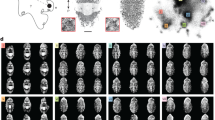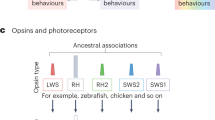Abstract
We review recent research on the visual mechanisms of rapid adaptive camouflage in cuttlefish. These neurophysiologically complex marine invertebrates can camouflage themselves against almost any background, yet their ability to quickly (0.5–2 s) alter their body patterns on different visual backgrounds poses a vexing challenge: how to pick the correct body pattern amongst their repertoire. The ability of cuttlefish to change appropriately requires a visual system that can rapidly assess complex visual scenes and produce the motor responses—the neurally controlled body patterns—that achieve camouflage. Using specifically designed visual backgrounds and assessing the corresponding body patterns quantitatively, we and others have uncovered several aspects of scene variation that are important in regulating cuttlefish patterning responses. These include spatial scale of background pattern, background intensity, background contrast, object edge properties, object contrast polarity, object depth, and the presence of 3D objects. Moreover, arm postures and skin papillae are also regulated visually for additional aspects of concealment. By integrating these visual cues, cuttlefish are able to rapidly select appropriate body patterns for concealment throughout diverse natural environments. This sensorimotor approach of studying cuttlefish camouflage thus provides unique insights into the mechanisms of visual perception in an invertebrate image-forming eye.









Similar content being viewed by others
References
Allen JJ, Mäthger LM, Barbosa A, Hanlon RT (2009) Cuttlefish use visual cues to control three-dimensional skin papillae for camouflage. J Comp Physiol A 195:547–555
Allen JJ, Mäthger LM, Barbosa A, Buresch KC, Sogin E, Schwartz J, Chubb C, Hanlon RT (2010) Cuttlefish dynamic camouflage: responses to substrate choice and integration of multiple visual cues. Proc Biol Sci 277:1031–1039
Anderson JC, Baddeley RJ, Osorio D, Shashar N, Tyler CW, Ramachandran VS, Crook AC, Hanlon RT (2003) Modular organization of adaptive colouration in flounder and cuttlefish revealed by independent component analysis. Network 14:321–333
Barbosa A, Mäthger LM, Chubb C, Florio C, Chiao C-C, Hanlon RT (2007) Disruptive coloration in cuttlefish: a visual perception mechanism that regulates ontogenetic adjustment of skin patterning. J Exp Biol 210:1139–1147
Barbosa A, Litman L, Hanlon RT (2008a) Changeable cuttlefish camouflage is influenced by horizontal and vertical aspects of the visual background. J Comp Physiol A 194:405–413
Barbosa A, Mäthger LM, Buresch KC, Kelly J, Chubb C, Chiao C-C, Hanlon RT (2008b) Cuttlefish camouflage: The effects of substrate contrast and size in evoking uniform, mottle or disruptive body patterns. Vision Res 48:1242–1253
Barbosa A, Allen JJ, Mäthger LM, Hanlon RT (2012) Cuttlefish use visual cues to determine arm postures for camouflage. Proc Biol Sci 279:84–90
Bex PJ, Makous W (2002) Spatial frequency, phase, and the contrast of natural images. J Opt Soc Am A: 19:1096–1106
Boycott BB (1961) The functional organization of the brain of the cuttlefish Sepia officinalis. Proc R Soc Lond B 153:503–534
Buresch KC, Mathger LM, Allen JJ, Bennice C, Smith N, Schram J, Chiao C-C, Chubb C, Hanlon RT (2011) The use of background matching vs. masquerade for camouflage in cuttlefish Sepia officinalis. Vision Res 51:2362–2368
Chiao C-C, Hanlon RT (2001a) Cuttlefish camouflage: visual perception of size, contrast and number of white squares on artificial checkerboard substrata initiates disruptive coloration. J Exp Biol 204:2119–2125
Chiao C-C, Hanlon RT (2001b) Cuttlefish cue visually on area - not shape or aspect ratio - of light objects in the substrate to produce disruptive body patterns for camouflage. Biol Bull 201:269–270
Chiao C-C, Kelman EJ, Hanlon RT (2005) Disruptive body patterning of cuttlefish (Sepia officinalis) requires visual information regarding edges and contrast of objects in natural substrate backgrounds. Biol Bull 208:7–11
Chiao C-C, Chubb C, Hanlon RT (2007) Interactive effects of size, contrast, intensity and configuration of background objects in evoking disruptive camouflage in cuttlefish. Vision Res 47:2223–2235
Chiao C-C, Chubb C, Buresch K, Siemann L, Hanlon RT (2009) The scaling effects of substrate texture on camouflage patterning in cuttlefish. Vision Res 49:1647–1656
Chiao C-C, Chubb C, Buresch KC, Barbosa A, Allen JJ, Mäthger LM, Hanlon RT (2010) Mottle camouflage patterns in cuttlefish: quantitative characterization and visual background stimuli that evoke them. J Exp Biol 213:187–199
Chiao C-C, Ulmer KM, Siemann LA, Buresch KC, Chubb C, Hanlon RT (2013) How visual edge features influence cuttlefish camouflage patterning. Vision Res 83:40–47
Chichery R, Chanelet J (1976) Motor and behavioral responses obtained by stimulation with chronic electrodes of the optic lobe of Sepia officinalis. Brain Res 105:525–532
Chung WS, Marshall NJ (2014) Range-finding in squid using retinal deformation and image blur. Curr Biol 24:R64–R65
Gonzalez-Bellido PT, Wardill TJ, Buresch KC, Ulmer KM, Hanlon RT (2014) Expression of squid iridescence depends on environmental luminance and peripheral ganglion control. J Exp Biol 217:850–858
Hanlon RH (2007) Cephalopod dynamic camouflage. Curr Biol 17:R400–R404
Hanlon RT, Messenger JB (1988) Adaptive coloration in young cuttlefish (Sepia officinalis L.): The morphology and development of body patterns and their relation to behaviour. Philos Trans R Soc Lond B 320:437–487
Hanlon RT, Messenger JB (1996) Cephalopod Behaviour. Cambridge University Press, Cambridge
Hanlon RT, Chiao C-C, Mäthger LM, Barbosa A, Buresch KC, Chubb C (2009) Cephalopod dynamic camouflage: bridging the continuum between background matching and disruptive coloration. Philos Trans R Soc Lond B Biol Sci 364:429–437
Hanlon RT, Chiao C-C, Mäthger LM, Buresch KC, Barbosa A, Allen JJ, Siemann L, Chubb C (2011) Rapid adaptive camouflage in cephalopods. In: Stevens M, Merilaita S (eds) Animal camouflage: mechanisms and functions. Cambridge University Press, Cambridge, U.K.
Hanlon RT, Chiao C-C, Mathger LM, Marshall NJ (2013) A fish-eye view of cuttlefish camouflage using in situ spectrometry. Biol J Linn Soc 109:535–551
Kelman EJ, Tiptus P, Osorio D (2006) Juvenile plaice (Pleuronectes platessa) produce camouflage by flexibly combining two separate patterns. J Exp Biol 209:3288–3292
Kelman EJ, Baddeley RJ, Shohet AJ, Osorio D (2007) Perception of visual texture and the expression of disruptive camouflage by the cuttlefish, Sepia officinalis. Proc Biol Sci 274:1369–1375
Kelman EJ, Osorio D, Baddeley RJ (2008) A review of cuttlefish camouflage and object recognition and evidence for depth perception. J Exp Biol 211:1163–1757
Marshall NJ, Messenger JB (1996) Colour-blind camouflage. Nature 382:408–409
Mäthger LM, Barbosa A, Miner S, Hanlon RT (2006) Color blindness and contrast perception in cuttlefish (Sepia officinalis) determined by a visual sensorimotor assay. Vision Res 46:1746–1753
Mäthger LM, Chiao C-C, Barbosa A, Buresch KC, Kaye S, Hanlon RT (2007) Disruptive coloration elicited on controlled natural substrates in cuttlefish, Sepia officinalis. J Exp Biol 210:2657–2666
Mäthger LM, Roberts SB, Hanlon RT (2010) Evidence for distributed light sensing in the skin of cuttlefish, Sepia officinalis. Biol Lett 6:600–603
Mäthger LM, Hanlon RT, Hakansson J, Nilsson DE (2013) The W-shaped pupil in cuttlefish (Sepia officinalis): functions for improving horizontal vision. Vision Res 83:19–24. doi:10.1016/j.visres.2013.02.016
Messenger JB (1991) Photoreception and vision in molluscs. In: Cronly-Dillon JR, Gregory RL (eds) Vision and visual dysfunction, vol 2., Evolution of the eye and visual systemMacmillan Press, London, pp 364–397
Messenger JB (2001) Cephalopod chromatophores: Neurobiology and natural history. Biol Rev 76:473–528
Nilsson DE, Warrant EJ, Johnsen S, Hanlon RT, Shashar N (2013) The giant eyes of giant squid are indeed unexpectedly large, but not if used for spotting sperm whales. BMC Evol Biol 13:187
Packard A (1972) Cephalopods and fish: the limits of convergence. Biol Rev 47:241–307
Packard A (1982) Morphogenesis of chromatophore patterns in cephalopods: Are morphological and physiological ‘units’ the same? Malacologia 23:193–201
Ramachandran VS, Tyler CW, Gregory RL, Rogers-Ramachandran D, Duensing S, Pillsbury C, Ramachandran C (1996) Rapid adaptive camouflage in tropical flounders. Nature 379(6568):815–818
Saidel WM (1988) How to be unseen: An essay in obscurity. In: Fay RR, Popper AN, Tavolga WN (eds) Atema J. Sensory Biology of Aquatic Animals Springer-Verlag, New York, pp 487–513
Shohet A, Baddeley R, Anderson J, Osorio D (2007) Cuttlefish camouflage: a quantitative study of patterning. Biol J Linn Soc 92:335–345
Stevens M, Merilaita S (2011) Animal Camouflage: Mechanisms and Function. Cambridge University Press, Cambridge
Troscianko T, Benton CP, Lovell PG, Tolhurst DJ, Pizlo Z (2009) Camouflage and visual perception. Philos Trans R Soc Lond B 364:449–461
Tublitz NJ, Gaston MR, Loi PK (2006) Neural regulation of a complex behavior: body patterning in cephalopod molluscs. Integr Comp Biol 46:880–889
Tyrie EK, Hanlon RT, Siemann L, Uyarra MC (2015) Coral reef flounders, Bothus lunatus, choose substrates on which they can achieve camouflage with their limited body pattern repertoire. Biol J Linn Soc (in press)
Young JZ (1962) The optic lobes of Octopus vulgaris. Philos Trans R Soc Lond B 245:19–58
Young JZ (1974) The central nervous system of Loligo. I. The optic lobe. Philos Trans R Soc Lond B 267:263–302
Zylinski S, Osorio D (2011) What can camouflage tell us about non-human visual perception? A case study of multiple cue use in the cuttlefish. In: Stevens M, Merilaita S (eds) Animal camouflage: mechanisms and functions. Cambridge University Press, Cambridge, U.K.
Zylinski S, Osorio D, Shohet AJ (2009a) Edge detection and texture classification by cuttlefish. J Vision 9:1–10
Zylinski S, Osorio D, Shohet AJ (2009b) Perception of edges and visual texture in the camouflage of the common cuttlefish, Sepia officinalis. Philos Trans R Soc Lond B 364:439–448
Zylinski S, Darmaillacq AS, Shashar N (2012) Visual interpolation for contour completion by the European cuttlefish (Sepia officinalis) and its use in dynamic camouflage. Proc Biol Sci 279:2386–2390
Author information
Authors and Affiliations
Corresponding author
Rights and permissions
About this article
Cite this article
Chiao, CC., Chubb, C. & Hanlon, R.T. A review of visual perception mechanisms that regulate rapid adaptive camouflage in cuttlefish. J Comp Physiol A 201, 933–945 (2015). https://doi.org/10.1007/s00359-015-0988-5
Received:
Revised:
Accepted:
Published:
Issue Date:
DOI: https://doi.org/10.1007/s00359-015-0988-5




